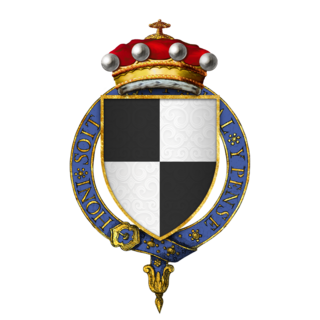Related Research Articles

William de Bohun, 1st Earl of Northampton, KG was an English nobleman and military commander.

Eleanor of Lancaster, Countess of Arundel was the fifth daughter of Henry, 3rd Earl of Lancaster and Maud Chaworth.

John Devereux, 1st Baron Devereux, KG, was a close companion of Edward, the Black Prince, and an English peer during the reign of King Richard II.
Theobald le Botiller, also known as Theobald Butler, 2nd Baron Butler was the son of Theobald Walter, 1st Baron Butler and Maud le Vavasour. He had livery of his lands on 18 July 1222.

Thomas Hoo, Baron Hoo and Hastings KG was a Knight of the Garter and English courtier. William Camden called him vir egregius, literally an "outstanding man". The Barony created in his name had no successors, and he had no male issue, but four daughters by two marriages, three elder half-sisters and a younger half-brother. Having served in military command in Normandy, he was Chancellor of France to King Henry VI of England, assisted in the negotiations for peace with the King of France in 1442–1444, and was in personal attendance on Margaret of Anjou in France during the months preceding her marriage. A servant of the Lancastrian throne, by the death of his friend the Earl of Suffolk in 1450 he lost his distinguished patron, but did not live to see the triumphs of the Yorkist cause in 1455 and 1460.

Giles de Badlesmere, 2nd Baron Badlesmere was an English nobleman.
Maud de Badlesmere, Countess of Oxford was an English noblewoman, and the wife of John de Vere, 7th Earl of Oxford. She, along with her three sisters, was a co-heiress of her only brother Giles de Badlesmere, 2nd Baron Badlesmere, who had no male issue.

Campsey Priory,, was a religious house of Augustinian canonesses at Campsea Ashe, Suffolk, about 1.5 miles (2.5 km) south east of Wickham Market. It was founded shortly before 1195 on behalf of two of his sisters by Theobald de Valoines, who, with his wife Avice, had previously founded Hickling Priory in Norfolk for male canons in 1185. Both houses were suppressed in 1536.
Sir Nicholas Haute, of Wadden Hall (Wadenhall) in Petham and Waltham, with manors extending into Lower Hardres, Elmsted and Bishopsbourne, in the county of Kent, was an English knight, landowner and politician.
William Gage was a major landowner and the father of the Tudor courtier Sir John Gage KG.

John Darras (c.1355–1408) was an English soldier, politician and landowner, who fought in the Hundred Years' War and against the Glyndŵr Rising. A client of the FitzAlan Earls of Arundel, he served them in war and peace, helping consolidate their domination of his native county of Shropshire. He represented Shropshire twice in the House of Commons of England. He died by his own hand.
Sir John Gage was a major landowner and grandfather of the Tudor courtier Sir John Gage KG.
Thomas St Clere was a son of Sir Philip St Clere of Penshurst Place. He was a major landowner whose estates included property in eight English counties.
Sir Philip St Clere was a son of Sir Philip St Clere of Ightham, Kent and Little Preston, Northamptonshire & his wife Joan de Audley. He served as High Sheriff of Surrey and Sussex and was a major landowner whose estates included land in eight English counties.
Margaret de Loveyne was a daughter of Sir Nicholas Loveyne and his second wife Margaret de Vere. She inherited extensive property and her second husband was High Sheriff of Surrey and Sussex.
Margaret de Vere was an English noblewoman, a daughter of John de Vere, 7th Earl of Oxford and his wife Maud de Badlesmere.
Sir Nicholas de Loveyne was a major English property owner and courtier, who held a number of senior positions in the service of King Edward III.

Sir John de Pulteney or Sir John Poultney was a major English entrepreneur and property owner, who served four times as Mayor of London.
Sir John Cornwall (c.1366–1414) was an English soldier, politician and landowner, who fought in the Hundred Years' War and against the Glyndŵr Rising. He had considerable prestige, claiming royal descent. As he was part of the Lancastrian affinity, the retainers of John of Gaunt, he received considerable royal favour under Henry IV. He represented Shropshire twice in the House of Commons of England. However, he regularly attracted accusations of violence, intimidation and legal chicanery. Towards the end of his life he fell into disfavour and he died while awaiting trial in connection with a murder.
Roesia de Verdun, also spelled Rohese and Rose, was a Norman femme sole and one of the most powerful women of Ireland in the 13th century.
References
- ↑ Sheppard, Walter Lee. "Sir Nicholas de Loveyne and his Two Wives, I". Genealogists' Magazine. London: Society of Genealogists. 15: 251–2.
- ↑ John de Pulteney
- ↑ Calendar of Patent Rolls, Edward III, Vol. 2 (1330-4), page 22.
- ↑ Calendar of Close Rolls, Edward II, (1313-1318), page 623.
- ↑ Calendar of Inquisitions Post Mortem, 1st series, Vol. 9, No. 183.
- ↑ Calendar of Inquisitions Post Mortem, 1st series, Vol. 12, No. 162.
- ↑ Calendar of Inquisitions Post Mortem, 1st series, Vol. 9, No. 183.
- ↑ Calendar of Close Rolls, (1349-54), page 249.
- ↑ Calendar of Patent Rolls (1348-50), page 577.
- ↑ Calendar of Close Rolls (1364-8), pages 394-6.
- ↑ "Richard, Earl of Arundel v John de Pulteney (Kent)" . Retrieved 10 June 2017.
- ↑ "Richard, Earl of Arundel v John de Pulteney (Cambridgeshire)" . Retrieved 10 June 2017.
- ↑ Calendar of Inquisitions Post Mortem, 1st series, Vol. 12, No. 162.
- ↑ Blair, John (1980). "Henry Lakenham, Marbler of London, and a Tomb Contract of 1376". Antiquaries Journal. London: Society of Antiquaries of London. 60: 69. doi:10.1017/S0003581500035976.
- ↑ The Cistercian abbey of St Mary Graces, East Smithfield, London. London: Museum of London. 2011.